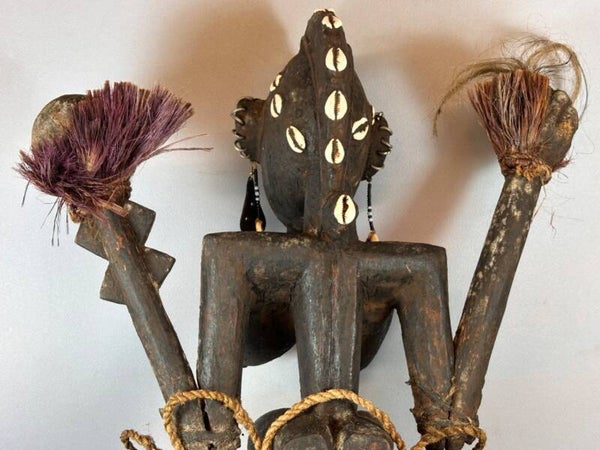250729 - Large Old African Dogon Satimbe Mask - Mali.
Large Old African Dogon Mask - Mali.
Height 71 cm.
This Dogon mask is dated from the mid of the 20th century and comes with a certificate of authenticity.
One of these is this Satimbe mask, or "High Lady", or "Sister of the Masks". It is surmounted by a beautiful statue of a young girl, representing the first woman to be ordained as a yasigine.
This is a satimbe ("sister on the head") mask, in which the rectangular part common to most Dogon wooden masks, is surmounted by a standing female figure with outstretched arms. This figure represents yasigine, the only woman admitted to the Awa male society. These few female members of Awa stand for the collective woman who, in origin stories, first discovered masks.
This remarkable mask is heavy and very delicate to wear, even for an experienced dancer. This mask embodies a sense of perfection, which respects the myth of the yasigine. It is an aesthetic emotion of creation.
The yasigine was the first woman to find the fibers and received as a badge a cowrie shell belt and a gourd with a long handle. Her birth must have taken place during the festivals or within the three preceding months: she must be the daughter of the yasigine (but will not receive this title until after her death) and in addition she must have been designated by the Council of Elders (actually revealed by divination).
To be enthroned, the Yasigine offers a salt stick of one cubit, ten pots of beer, three baskets of sesame seeds, three baskets of tobacco and one basket of spices. She must prepare the sesame oil for the rituals.
The ritual gourd of the Yasigine is harvested by her family at the time of the Sigui. She is the only woman allowed to approach the dancers and participate in the initiation celebrations.
ORIGIN:
This mask was collected, along with other objects, by Eliane Prévost, a French ethnologist who lived among the Dogon and wrote several books for Editions L'Harmattan.
Dogon masks surmounted by animals- or female figures are called satimbe, commemorating a mythological woman who first discovered and wore a mask. According to myth, her husband stole this mask, and from that time on Dogon women have been prohibited from wearing or coming close in contact with masks. The satimbe also represents the Yasigne, or "sisters of the mask", women who are born during the sigi festival, held every sixty years to honor the apprearance of death among humans.
The yasigne are the only women allowed to approach the masks and are involved in the performaces. Today, Dogon masks are used less often for dama festivals and are instead worn during secular performances, either greeting visiting tourists or in the celebration of civic events. Unlike contemporary satimbe masks, which are more naturalistic in their stylization of the human form, this mask has a more minimalist and abstract form.
Dogon art is not a single fixed style as has been often characterized in discussions of their sculpture, for the age of Dogon art extends to the past as early as the 12th century and continues to be created in the present with a number of sub-styles measured against the core of an identifiable Dogon art and style. The Dogon interchange stylistic elements with neighboring groups producing an interesting hybridism in some of their interesting sub-styles. This sculpture reflects an influence that neighboring groups can have on the well defined core of Dogon sculpture. West of the Dogon heartland the Dogon interact with the other major art producing people of Mali, the Bamana (Bambara). These figures show the influence of the Mande speaking Bamana (the Dogon are Gur language speakers – different language, different cultures!) in sculptural attributes well defined. These include a squared body, keel shaped head and ‘U’- shaped ears. A Bamana blacksmith could easily have carved the figure. If truly a Dogon figure it represented an ancestor identified to an individual, family, village or region. If an ancestor it represents either a familial ancestor or one of the original eight Nommo who descended to earth to create us, the world and continue to be interested in the affairs of man.
Recommended Reading: Laude's AFRICAN ART OF THE DOGON, Amex DOGON STATUARY, Ezra's ART OF THE DOGON, Ndiaye's ARTS DU PAYS DOGON.



























